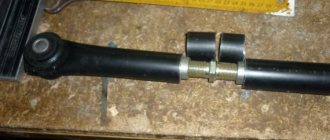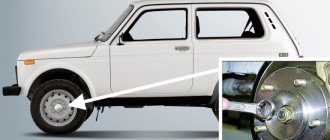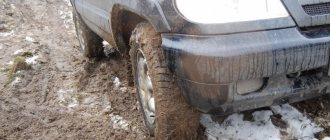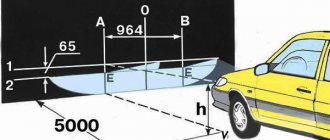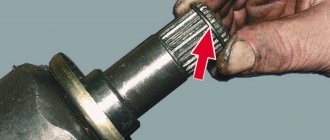At one time, the Chevrolet Niva was developed as a modern car for driving on bad roads. Of course, it’s impossible to fully call it an “off-road conqueror.” However, for everyday driving in rural areas, the car has everything you need: good equipment, a simple suspension design, permanent all-wheel drive, short wheelbase and small overhangs front and rear. The main purpose of off-road tuning is to increase the vehicle's cross-country ability.
Arch cutting and lift
To install 29-inch tires on the Niva, you will need to cut the arches. In principle, you can get by with one sharp cut, but it is better to also make a 5 cm lift, then in the maximum diagonals there will be nothing to rub anywhere. You can cut the arches yourself, fortunately there are a lot of video instructions.
The elevator will cost you the purchase of a special elevator kit, the price tag is around 5-6 thousand rubles.
Replacing GP (main pairs) - for tires 29″ and higher
So, the lift is cutting arches - you can already install 29″ tires. However, the wheels turn out to be too large and it will be difficult for the engine to turn them. Therefore, replacement of the GP (main pairs) immediately suggests itself. By default, Niva has GP 3.9, and for large wheels you need to take GP 4.3. And then the dynamics of the car will not decrease; it will pull perfectly along the highway and uphill. And if you drive 3.9, then your maximum gear on the highway is fourth, and then uphill. No, of course, you can ride off-road with 3.9, there’s not much difference. But on the highway you will immediately feel it. Replacing the GP with 4.3 will cost you the purchase of new pairs - the cost is about 9,000 rubles.
Next up are 29″ tires. There are a lot of options, you can choose a cool one for 5-7 thousand rubles.
So, the tires are set at your discretion - either regular or requiring modifications from the car. Next - body kit and external tuning.
When is modernization needed?
The higher and more high-torque the car, the easier and more comfortable it is to overcome a variety of obstacles in conditions of bad roads or no roads at all. The Chevrolet Niva is already endowed with off-road qualities from the factory. But there are always places where it is better not to go without additional modernization.
In addition to improving off-road performance, every car owner strives to give his iron horse a unique appearance. Often there are very extraordinary specimens with off-road tuning. Among the disadvantages of the off-road modernization of the Niva, the high cost of such work is noted. In some cases, the price of modifications can be equal to the car itself. In addition, some elements, for example, kangurins, require permission from the traffic police for installation.
Power thresholds and bumpers
Thresholds are needed primarily for jacking with a hijack (see below for what this is). Power thresholds are plus 4-5 thousand.
Bumper - or, as it is also called, “silovik”. A power bumper is an indispensable attribute of any SUV that is being prepared for off-road use. You can cook it yourself or buy it at a specialty store. It’s better, of course, to get it from a store to avoid problems with the traffic police, but it won’t be cheap.
For example, a very popular front bumper costs 25,000 rubles. It comes with headlight protection and a hole for a winch. Looks cool and the quality is top notch. But protecting the headlights also sometimes annoys the traffic police, it turns out like a kangaroo, which they like to get to the bottom of. Therefore, it is better to take a model from the OJ company - it is cheaper, 18,000 rubles and the bumper is not as noticeable as the Rif one.
Also interesting: Chevrolet Niva lifting - preparation for the hunting and fishing season
Sequence of tuning a Niva car
The first thing on the tuning list should be replacing tires. Factory tires, even new ones, are definitely not suitable for off-road use. Need good mud tires. But their installation will immediately affect the noise level when driving on asphalt.
No amount of sound insulation will save you. But that's not so bad. The fact is that the 29-inches recommended for installation do not fit into standard arches. It will be necessary to trim, of course, not the tires, but the arches. They can also be lifted, but then you will have to replace the main pairs of gearboxes. The gear ratio should be 4.3 or 4.7. The drives and axle shafts will need to be strengthened, and stronger wheels will need to be installed. The body will also require serious strengthening. You need to start by installing power bumpers and thresholds, without which it will be difficult for the body to withstand the loads that appear on the roads.
Be sure to protect the crankcase and transfer case from stones and stumps on the way. Recommended distribution ratio is 3:1. And for more remote and impassable places, a second stage of tuning will be needed. And then self-blocks are installed in the bridges.
When the Niva “hangs” in a rut, they will allow all wheels to rotate simultaneously, which means that the car has every chance of getting out of the rut without the help of passengers.
For forests and fields, the list provides for the installation of a power bumper and a high-quality (naturally, not Chinese) winch, or better yet two at once - front and rear.
And an eight-millimeter Kevlar cable for reliability. The force can be at least 3 tons. And so that the body does not bend, you need to scald the side members. This is especially important for five-door Niva car models.
Additional off-road equipment
Now about overcoming obstacles. When off-road, a reinforced jack (hijack) can be useful, capable of lifting a car more than a meter above the ground. It is also used as a hand winch, with which the car can be pulled out of the mud.
Iron slats (sandtracks) purchased in a timely manner and placed under the wheels will help save energy. They are metal plates with hooks over their entire surface.
A device that ensures uninterrupted operation of the engine under water (snorkel) will save the car when overcoming water obstacles.
For initial tuning, the above will be enough. But these measures are suitable for off-road driving. For off-road use, the Niva will need an expeditionary trunk, on which a light must be installed.
These lights are especially good for wading in the dark, or just at dusk. After all, standard headlights may be flooded and inoperative.
Niva car engine tuning
To help the engine, which overheats from loads, electric fans with sensors for radiators are installed in carburetor Nivas.
Instead of standard ones, which have forced activation, since they cannot cope with cooling when passing a rut at low speed. A hot engine may not last long when operating in this mode. In addition, when the car is in the water, the mechanical fan removes all the dirt, and the electric one can be turned off. The pistons should be replaced with forged ones.
They will last longer than cast ones, but the main thing here is not their novelty, but the separate balancing of each piston. The block head also needs to be modified; a direct-flow exhaust system requires installation. The most important thing for an SUV is the firmware of the electronic control unit.
This will increase the engine power by ten horses. To overcome difficult off-road conditions, it is necessary to strengthen the lower camshaft. Its “help” will consist of increasing torque and improving engine performance at low speeds. The tuning possibilities are not limited, they allow you to improve the comfort of the interior and make the car a threat to any obstacles that arise along the way. You can find out all the most interesting and current news at our website quality21.
Power steering
The car is equipped with power steering, which significantly reduces the force on the steering wheel. If the power steering is not functioning (for example, when towing a vehicle with the engine not running), you can still steer the vehicle, but you will need to apply significantly more force to the steering wheel to do so. In extreme positions of the steering wheel, functional noise is allowed.
Warning
- Do not coast with the engine not running! In this case, the power steering does not work, putting you and other road users at risk.
- It is not allowed to hold the steering wheel in extreme positions for a long time.
Traffic in winter
Warning. Be very careful on wet or slippery roads - avoid sudden braking and sudden pressing and releasing of the accelerator pedal. Drive the car smoothly, without sudden movements of the steering wheel. Reduce speed only by gradually shifting to lower gears with partial braking using the service brakes. If, no matter what, the car begins to skid, turn the steering wheel in the direction of the skid and smoothly use the steering wheel and gas pedal to level the car.
At road intersections, ice often forms due to wheel slipping when starting off. Therefore, when approaching such places in advance, on a dry area, begin to reduce your speed.
In winter, it can be difficult to move away from a slippery area. To do this, engage second gear and, slowly releasing the clutch pedal, gradually increase engine speed. In some cases, it is useful to lock the center differential before driving.
In the mountains
Attention. When driving uphill, switch to lower gears in a timely manner, avoiding overloading the engine and jerking the car. If necessary, engage a lower gear in the transfer case.
On long descents, use the engine in braking mode with partial use of the service brakes.
Warning. Do not descend with the clutch disengaged and using only the service brakes. This will cause the brakes to heat up and the brake fluid to boil. Keep in mind that as altitude increases, the boiling point of brake fluid decreases. The boiling of brake fluid in the wheel cylinders means a complete failure of the service brakes - the brake pedal sinks.
In mountainous areas, keep to the right side of the road. The narrower road width and complex route profile require more attention and caution. When turning, give sound and light signals. When stopping on an uphill or downhill slope, turn the steering wheel all the way so that if the car starts moving spontaneously, its wheels will rest against the curb of the road.
On slippery roads, do not start driving up a steep hill until the vehicle in front has reached the top.

